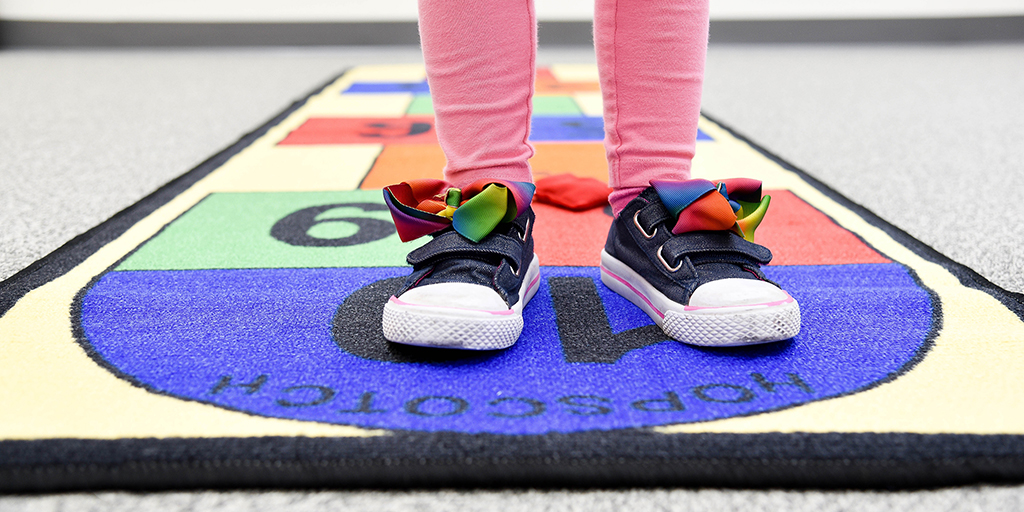
Hopscotch Reminds Us Life Is All About Balance

Danylo and Oskar Strakhov, Ukranian acrobats, know how to balance work life, family life and play time. (This photo was taken by Duo Polonsky.)
Danylo and Oskar Strakhov are a father and son duo from the Ukraine who perform amazing feats of balance. They dazzled audiences with a memorable acrobatic performance on America’s Got Talent in 2017 when Oskar was just 8 years old. How did they do it? Practice…Lots of practice.
Life is all about balance. Toddling 2-year olds usually don’t become acrobatic geniuses overnight. For this reason, playgrounds all over the world have been providing space for kids to play games centered around developing balance and other gross motor skills for generations. Hopscotch is an example of one of these classic playground favorites. Let’s dive into why some playground activities are more than just fun games.
Hopscotch Balances Many Skillsets
The history of hopscotch reveals a bit of controversy. Some say it was first played in England in 1677. Invented by the Romans, the original hopscotch courts stretched for over 100 feet in length and were used to train soldiers. Some claim the Chinese were the first to play. Regardless of who was the first, hopscotch has a rich heritage and has been played all over the world for hundreds of years. One of the appeals to hopscotch is the multi-faceted skillset necessary to play.
Cognitive Development
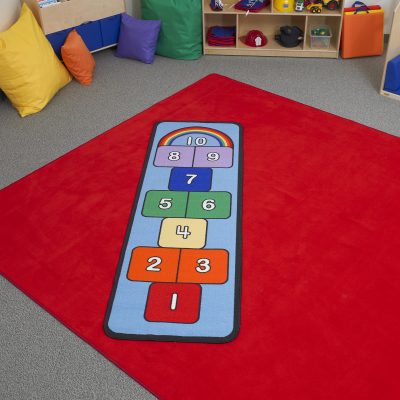
CF’s Rainbow Hopscotch Play Carpet (LC308) is the quintessential hopscotch rug with bright colors and a classic design.
Hopscotch has a set of rules that require kids to play with a purpose. The thought processes involved with learning where to throw the bean bag (or other object), how to jump through the squares, knowing which feet are supposed to land in which squares, whether to land on one foot or two, how to turn around at the top of the court, how to pick up your bean bag (or other object) on the way back while carefully skipping over that square, etc. Partnering the brainwork with the physical work involved is great for cognitive development.
Fine Motor Skills or Hand-Eye Coordination
Fine motor skills are used when tossing a bean bag into the right square without touching the line and then having the ability to retrieve it later. Toddlers will need hand-eye coordination to play many sports, to eat food with utensils, hold a pen or pencil and many other activities. It’s important to practice these skills from a very young age.
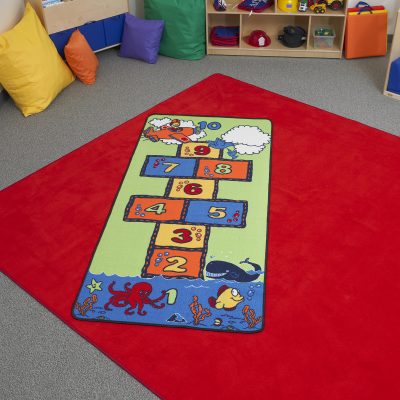
From Sea to Sky Hopscotch Carpet incorporates fun sea creatures and an airplane for visual interest. (LC182)
Gross Motor Skills (Balance)
All hopping takes balance and coordination. Muscle control and strength are developed while jumping and hopping. There are a million ways to work on gross motor skills, but hopscotch’s strength lies in the combination of so many different skills being used simultaneously.
Bilateral Coordination
This term refers to a child’s ability to use both sides of the body together in a coordinated way. Eating, dressing, cutting, and other every day tasks require bilateral coordination. Sports also require this advanced skill. Hopscotch is a perfect activity for mastering bilateral coordination. While hopping down the court, kids develop the ability to coordinate both sides of the body. Learning to hop on 1 foot then switch to 2 feet is an advanced skill for toddlers.
Social Skills
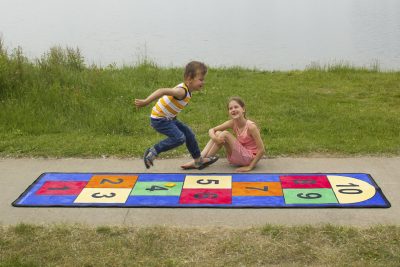
The Jumbo Large Hopscotch Educational Rug (CPR748) is big enough for plenty of kids to join in the fun!
Hopscotch can be played individually or in groups. We love the social development that occurs when children are encouraged to play in groups. Littles are forced to be patient, take turns, and cooperate when playing together.
Mathematical Skills
Each square on the hopscotch path is numbered. Memorizing numbers while jumping up and down the trail in ascending or descending order is experiential. It’s a kinesthetic way of learning numbers in a predominately visual and auditory world. Therefore, it lasers the order of the numbers in a child’s memory.
More Balance Activities
Children’s Factory doesn’t just focus on hopscotch carpets to give each toddler’s sense of balance a challenge. We have some other fun carpets focused on this skill.
Walk a Mile in Bigfoot’s Enormous Shoes (LC125)
In 2020, Microcebus jonahi was discovered in Madagascar. Named after the primatologist Jonah Ratsimbazafy, Jonah’s mouse lemur is the smallest species of lemur to date. Just when you imagined everything of importance had already been discovered, something new pops up. In this case, a very small primate came to light. It stands to reason, the possibility exists Bigfoot fans could be vindicated someday when he is suddenly verified as a “real” species.
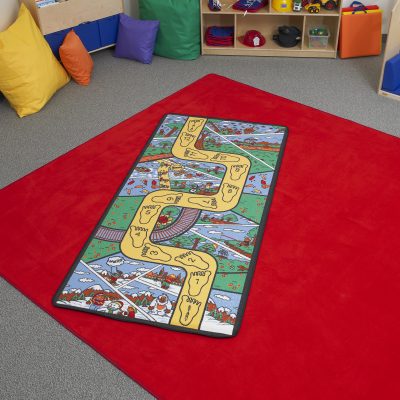
Whether we believe Bigfoot is real or not, this carpet is a great way to introduce tikes to Bigfoot is a fun way while working on balance. (LC125)
When a toddler’s imagination starts flowing in a positive direction, Children’s Factory considers it a win. Our Learn to Balance Play Carpet features footprints numbered 1-12 so toddlers can use gross motor skills to balance while walking in Bigfoot’s huge footprints. The 4 seasons are also highlighted to give teachers, parents, and caregivers the opportunity to discuss the balance found in nature.
Balance in all areas of life is important. In what ways are you proactively creating balance for your kiddos?